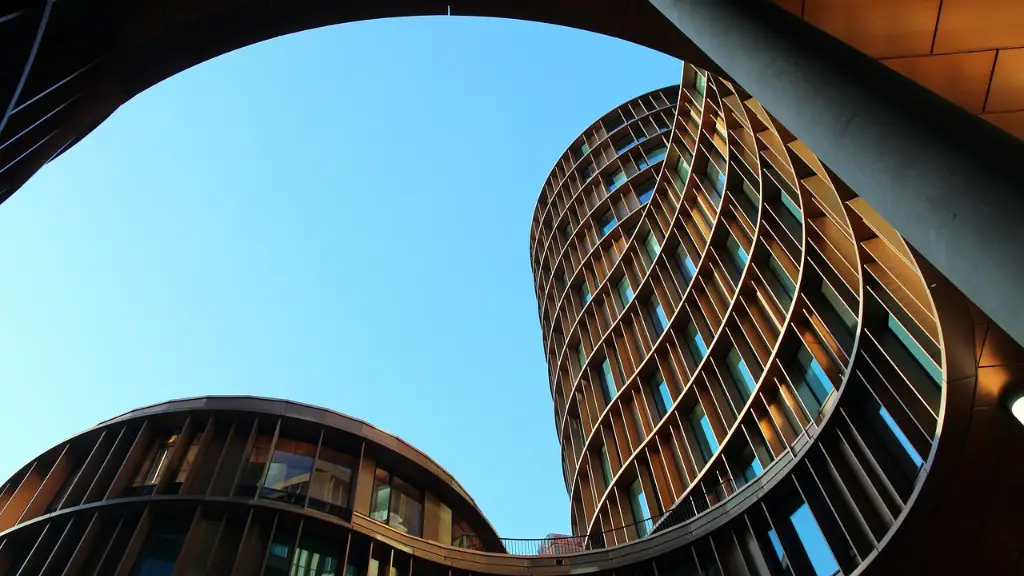Bioclimatic architecture is an approach to designing buildings that take into account the local climate. The goal is to create a comfortable indoor environment while minimizing the use of energy for heating and cooling. This can be achieved through the use of passive solar design, natural ventilation, and thermal mass.
Bioclimatic architecture is a type of architecture that focuses on using the environment to improve the comfort and energy efficiency of a building. This can be done through a variety of means, such as using passive solar design principles, using thermal mass to regulate indoor temperatures, and using brise soleil to shade windows and walls.
What is an example of bioclimatic architecture?
The Tower at PNC Plaza in Pittsburgh is a good example of a bioclimatic building. It is 33 stories tall and was designed by Paladino and Co and Gensler. The building takes advantage of natural ventilation and daylighting to save energy and create a comfortable environment for occupants.
Bioclimatic design is an important aspect of sustainable architecture. By taking into account the local climate and weather patterns, buildings can be designed to be more energy efficient and comfortable for occupants. By using passive solar design techniques, buildings can minimize the use of mechanical systems for heating and cooling, which can save energy and money.
What is the difference between bioclimatic architecture and sustainable architecture
Bioclimatic architecture is a type of sustainable architecture that takes into account both the biological and climatic aspects of a site in order to create a more comfortable and energy-efficient space. Some of the strategies used in bioclimatic architecture include passive solar design, natural ventilation, and thermal mass. Green architecture is another type of sustainable architecture that focuses on the use of sustainable materials and construction methods. While both bioclimatic and green architecture are concerned with sustainability, they are not necessarily the same thing.
The term “bioclimatic” refers to the study of the relationship between climate and living organisms. In the context of building design, bioclimatic design is a process that takes into account human thermal requirements and local climatic conditions in order to create a more comfortable and energy-efficient environment.
One tool that is often used in bioclimatic design is the bioclimatic chart. These charts plot the comfort zone in relation to various meteorological factors, such as air temperature, humidity, mean radiant heat, wind speed, and solar radiation. By understanding the comfort zone, designers can make more informed decisions about building orientation, window placement, and other factors that can impact the thermal comfort of occupants.
In addition to being more comfortable, bioclimatic design can also lead to energy savings. By taking into account the local climate, designers can minimize the need for artificial heating and cooling, which can save significant amounts of energy.
Overall, bioclimatic design is a holistic approach to building design that takes into account the impact of the environment on human comfort and energy use. By understanding the comfort zone and using it as a guide, designers can create more comfortable and energy-efficient buildings.
What are bioclimatic models used for?
Bioclimatic models are used to predict the geographic ranges of organisms as a function of climate. These models are based on the idea that the climatic conditions of an area determine the types of plants and animals that can live there. By understanding the relationship between climate and the distribution of species, we can better understand the potential impacts of climate change on the distribution of species.
The optimum level of atmospheric events enables people to carry out various activities. Extreme climate characteristics have affected the daily life activities, work, production, recreation and leisure activities of people.
What is the meaning of bioclimate?
A bioclimate is a climate that is influenced by, and influences, biological organisms. It can be used to refer to the climate of a specific area, or the climate of the Earth as a whole.
The term refers to designing buildings and spaces (interior and exterior) using local climatic conditions to improve thermal and visual comfort. This includes strategies such as using passive heating and cooling, natural ventilation, shading, and daylighting.
One of the main goals of is to reduce the energy consumption of buildings, which is often a significant contributor to greenhouse gas emissions. can also help to improve the indoor air quality of buildings and make them more comfortable places to occupy.
What are the major bioclimatic zones
Bioclimatic zones are areas with similar climates, vegetation, and soils. Some examples are deserts, savannas, tropical forests, steppes, temperate forests, and cold regions. Each bioclimatic zone has its own characteristic plants and animals.
If you’re interested in a career in green architecture, you’ll need to earn a professional degree in architecture from an accredited institution. The National Architectural Accrediting Board (NAAB) is the organization that accredits programs in the United States. Once you have your degree, you’ll be able to pursue a career in green architecture and help make a difference in the environment.
What is eco-friendly architecture called?
Sustainable architecture is a type of architecture that focuses on making structures that have minimal harmful effects to the environment. This can include using sustainable materials, renewable energy sources, and green building techniques. Sustainable architecture also challenges architects to create smart designs that take into account the community and the ecosystem.
Biophilic design is an approach to architecture that seeks to connect building occupants more closely to nature. This type of design incorporates things like natural lighting and ventilation, natural landscape features, and other elements to create a more productive and healthy built environment for people. This approach to design is becoming more popular as we learn more about the importance of connecting with nature and the positive effects it can have on our health and well-being.
What are the bioclimatic variables
The bioclimatic variables are important because they help us understand the annual trends in temperature and precipitation. They also help us understand the seasonality of these variables and the extreme or limiting environmental factors that can influence them.
A climate diagram is a brief summary of average climatic variables and their time course. They have proven useful for a wide range of sciences, industry, and teaching. In bio- and geosciences, they are used as an instrument to show the relationships between soil, vegetation, and climate.
How do you make a climate diagram?
When drawing bars on a graph, it is best to make them wide so that they are easier to see and draw. This makes the graph more accurate and easier to read.
Bioclimatic architecture is a type of green architecture that uses climatic factors to improve the sustainability of a building. By taking advantage of naturally-occurring climatic conditions, bioclimatic architecture can reduce the need for energy-intensive mechanical systems, such as air-conditioning and heating. This, in turn, can lead to a reduction in a building’s carbon footprint and water footprint. In addition, bioclimatic architecture can help to reduce noise pollution by using insulation to reduce the transmission of sound. Finally, bioclimatic architecture can improve sustainable habits by making sparing use of energy and other resources.
What are the two main types of climate models
When creating climate models, scientist generally use one of three types of simple climate models: energy balance models, intermediate complexity models, or general circulation models.
Energy balance models are the simplest type of climate model and are often used to study the Earth’s radiation budget. Intermediate complexity models are more complex and are used to study atmospheric dynamics. General circulation models are the most complex type of climate model and are used to study both the atmosphere and the ocean.
Palaeoclimate models help us to understand how different factors can affect global climate change. By studying how ice sheets respond to different levels of greenhouse gases, we can better predict future sea level rise and the impacts it will have on our planet.
Final Words
Bioclimatic architecture is an approach to design that takes into account the local climate in order to create a more comfortable and efficient built environment. This can involve things like orienting a building to make the most of solar gain in the winter, or using shading and natural ventilation to keep a space cool in the summer.Bioclimatic architecture is sometimes also known as climate-responsive design or climate-adaptive design.
Bioclimatic architecture is an approach to design that takes into account the local climate in order to create a building that is comfortable and energy efficient. By using features such as passive solar heating and natural ventilation, bioclimatic architecture can provide a significant reduction in energy consumption.





